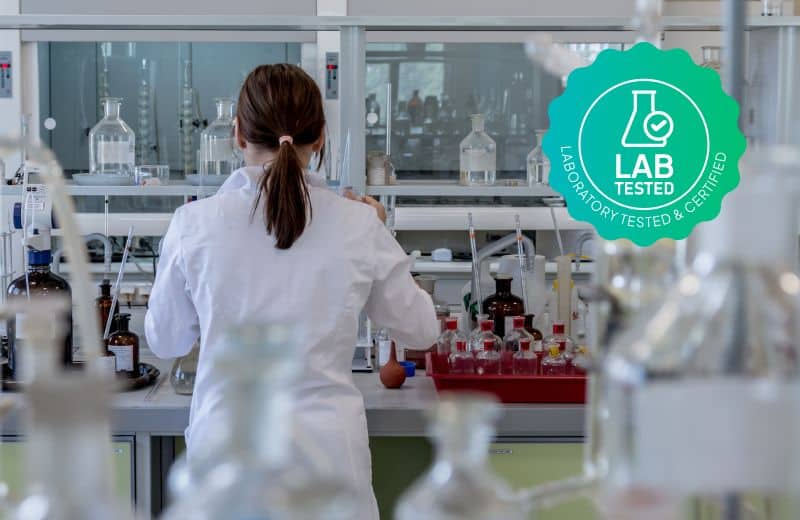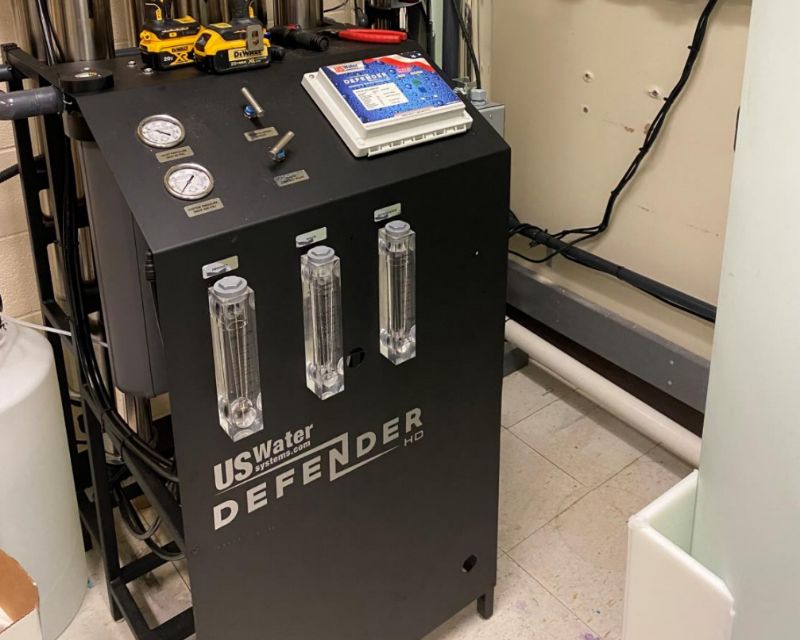Chromium is a tasteless, odorless metallic element that is harmful to health when found in high levels in drinking water. In this glossary, you’ll learn more about chromium in water, including how it gets there, its health effects, and how to protect your family from this contaminant.
Table of Contents
- ❔ What is Chromium?
- 🩺 What are the Potential Health Effects of Chromium?
- 🚰 How Does Chromium Get Into Drinking Water?
- 📉 Do Water Treatment Facilities Monitor Levels of Chromium in Drinking Water?
- 🔎 How Can I Tell if Chromium is in My Drinking Water?
- 👩🏽⚕️ How Can I Protect My Family from Chromium in Drinking Water?
- ⚠️ How Else Can I Be Exposed to Chromium?
- 📝 Where Can I Get More Information?
❔ What is Chromium?
Chromium is an element that occurs in several forms naturally in the environment. The two most common forms of chromium are chromium 3 (trivalent chromium) and chromium 6 (hexavalent chromium).
💡 Chromium 3 is essential to human health, and is found in meats, grains, fruits, vegetables and yeast. Chromium 6, however, isn’t an essential dietary element and is known to have dangerous side effects when consumed or inhaled.
| In Water As | Trivalent Cr(III): Cr+3 Hexavalent Cr(VI): Cr2O7-2, CrO4-2 |
| Sources | Trivalent chromium is from natural sources Hexavalent is found in hazardous waste sites |
| Maximum Contaminant Levels (MCLs) | US EPA: 0.1 mg/L; 100 PPB WHO Guideline: 0.05 mg/L EWG: 0.00002 mg/L |
| Potential Health Risks | Nausea Gastrointestinal distress Allergic dermatitis Lung and nasal cancer Stomach and skin ulcers Reproductive problems Risk of kidney and liver damage |
| Treatments | Reverse Osmosis Ion Exchange Distillation Lime Softening |
🩺 What are the Potential Health Effects of Chromium?
According to the WQA, some of the potential health effects of hexavalent chromium exposure in drinking water are:
- Gastrointestinal distress
- Nausea
- Skin and stomach ulcers
- Allergic dermatitis
- Reproductive problems
- Kidney and liver damage
- Lung and nasal cancer
Chromium 3 is an essential human nutrient that is associated with little or no toxicity. Chromium 6 is the more toxic form of chromium and is most likely to be a danger to public health when consumed in water. So, the type of chromium in your water determines the potential health risks.

🚰 How Does Chromium Get Into Drinking Water?
There are two common ways that chromium gets into drinking water: from natural sources in the environment, and through industrial pollution.
Natural chromium deposits are found in the environment, including air, gases, animals, rocks, soil, and volcanic dust. When these deposits erode, chromium is released into the ground. Chromium occurs naturally in surface water and groundwater that seeps through soils containing chromium.
Chromium is also found in hazardous waste sites, and is produced during a number of industrial processes. Poor storage, leakage, and improper waste disposal practices can all cause chromium and other toxic substances to leach into the environment.
📉 Do Water Treatment Facilities Monitor Levels of Chromium in Drinking Water?
Yes, water treatment facilities monitor chromium levels in water according to national and local guidelines.
Chromium is known to convert back and forth in the human body and in water, depending on environmental conditions, so the Environmental Protection Agency (EPA) has a drinking water standard for total chromium (including trivalent chromium and hexavalent chromium), as required by the Safe Drinking Water Act (SDWA)..
📌 All water treatment facilities must adhere to the EPA guideline of 0.1 mg/L or 100 PPB (parts per billion) for total chromium in public drinking water. Facilities must test and treat their water according to the third Unregulated Contaminant Monitoring Rule, and routinely provide evidence of contaminant reduction to the EPA, providing that their chloramine levels don’t surpass this Maximum Contaminant Level.
Some states may have tighter restrictions on chromium in drinking water that override the EPA’s drinking water standard. For instance, the Environmental Health Hazard Assessment of the California Environmental Protection Agency has a proposed limit of 0.02 PPB (parts per billion) after discovering new information about the health risks of chromium 6 in sensitive and young populations.
There are several more guidelines for total chromium to be aware of:
- World Health Organization (WHO) guideline: 0.05 mg/L
- Health Canada Maximum Acceptable Concentration: 0.05 mg/L
Water utilities do monitor levels of chromium in drinking water. However, some organizations, like the Environmental Working group (EWG), believe that the EPA’s Maximum Contaminant Level for total chromium is too low. So, while total chromium is regulated under the Safe Drinking Water Act, it may still be dangerous in “safe” concentrations. Plus, the EWG found that more than 8,000 facilities in 50 states have chromium levels higher than health guidelines in their water.
It’s also worth noting that the EPA’s drinking water standards for chromium were established in the early 90s and were based on the best available science more than three decades ago. A more comprehensive risk assessment of this element – especially the hexavalent form – could result in a new, more stringent federal standard being introduced.

🔎 How Can I Tell if Chromium is in My Drinking Water?
Chromium is a tasteless metallic element, so you won’t know by tasting your water whether it contains this element, and how much. Chromium also has no smell, and doesn’t affect the appearance of water.
The only way to know how much chromium is in your tap water is to test a water sample. A professional laboratory can conduct a thorough chromium test, providing information on your water’s hexavalent chromium, trivalent chromium, and total chromium levels, and how these compare to national enforceable standards for public health.
Reading your Consumer Confidence Report, or Water Quality Report, can also give you an idea of how much chromium your treated water contains. Keep in mind, though, that chromium levels in public water systems may fluctuate on a day-to-day basis, and the report is only accurate to one day out of the entire year.

Learn more about other common toxins in water in our full guide.
👩🏽⚕️ How Can I Protect My Family from Chromium in Drinking Water?
Unfortunately, there’s not much you can do to prevent your water facility from delivering water containing hexavalent chromium to your home. However, you can remove chromium from your water before you drink it.
Some of the best treatment technology options for removing chromium are:
- Reverse osmosis – This system treats water with several filtration stages and a semi-permeable membrane, which removes virtually all total dissolved solids, including more than 99% hexavalent chromium. Reverse osmosis is the best protection against chromium in tap water.
- Ion exchange – This treatment technology is most widely used to remove calcium and magnesium in a water softener. Ion or cation exchange are most commonly used to remove or reduce chromium in wastewater treatment.
- Lime softening – This involves increasing water’s pH level and softening water by adding a substance (usually soda ash) to the water. Soda ash systems are typically installed as point of entry systems, providing whole home treatment of water supplies.
If you’ve tested your water and discovered that your hexavalent chromium levels are high, you may want to switch to bottled water while you research and purchase a suitable water treatment solution. Learn about the best RO systems for chromium reduction here.

⚠️ How Else Can I Be Exposed to Chromium?
Chromium occurs naturally in the environment, which means that our exposure to this element doesn’t only come from drinking water.
Some of the other ways you might be exposed to trivalent and hexavalent chromium are:
- Industrial air contamination – If you work in an industrial facility where chromium is released into the air, you’re at a higher-than-average risk of chromium exposure through inhalation
- Environmental sources – Cement dust, airborne emissions, and contaminated landfill may all release chromium into the environment
- Consumer products – Antifreeze, cement, and some wood preservatives contain hexavalent chromium
- Foods – Many vegetables, grains, and meats contain small amounts of chromium
- Smoking – Tobacco smoke is known to contain hexavalent chromium
📌 Remember, only hexavalent chromium is harmful to health. So, it’s fine – and good for you – to consume foods that contain trivalent chromium.
📝 Where Can I Get More Information?
To learn more about chromium in drinking water, including its potential health effects, check out the links below.
